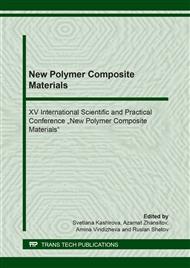[1]
Khakimullin Yu.N. et al. Non-woven materials based on polymers used for the production of medical clothes and linen, sterilized by radiation: types of materials, technology of production of radiation: types of materials, production technology // Bulletin of Kazan Technological University. 2011. Vol. 23. P. 97–103.
Google Scholar
[2]
Travkina L.S. et al. Influence of ionizing radiation on the properties of nonwoven materials for medical purposes // Bulletin of Kazan Technological University. 2013. Vol. 84. P. 487–492.
Google Scholar
[3]
Hosun L. A review of spun bond process // J. Text. Apparel, Technol. Manag. 2010. Vol. 6, No. 3. P. 1–13.
Google Scholar
[4]
Acar M., Harper J.F. Textile composites from hydro-entangled non-woven fabrics // Comput. Struct. 2000. Vol. 76, № 1. P. 105–114.
DOI: 10.1016/s0045-7949(99)00167-4
Google Scholar
[5]
Czajka R. Development of medical textile market // Fibres Text. East. Eur. 2005. Vol. 13, № 1. P. 13–15.
Google Scholar
[6]
Tang S.L.P., Stylios G.K. An overview of smart technologies for clothing design and engineering // Int. J. Cloth. Sci. Technol. 2006. Vol. 18, № 2. P. 108–128.
Google Scholar
[7]
Berejka A.J., Cleland M.R. Industrial Radiation Processing With Electron Beams and X-rays. 2011. No. May. 105 p.
Google Scholar
[8]
Berejka A. Polymers Status and Prospects. Vienna, 2005. № August. 146 p.
Google Scholar
[9]
Kargin V.A. Radiation chemistry of polymers / ed. M .: Science. 1973. 320 p.
Google Scholar
[10]
Mamedov S., Garibov A. Radiation physics and chemistry of polymers / ed. Deutschland S.A.P. 2015. 547 p.
Google Scholar
[11]
Perova M.S. et al. Influence of the Molecular Weight of Oligoisobutylenes on the Properties of Uncured Sealants // Int. Polym. Sci. Technol. 2011. Vol. 38, No. 12. P. 9–11.
DOI: 10.1177/0307174x1103801203
Google Scholar
[12]
Rakhmatullina E.R. et al. Effect of processing conditions on the properties of polypropylene // Deformation and destruction of materials. 2017. Vol. 12. P. 35–39.
Google Scholar
[13]
Veselovsky R.A., Leshchenko S.S., Karpov V.L. On some features of the radiation chemistry of polypropylene in the field of low doses // M.: Nauka. 1966. 268-271 p.
Google Scholar
[14]
Gahleitner M. et al. Sterilization effects on polypropylene: technology and polymer type effects // 9th EUROPLACE Conference. 2003. P. 25.
Google Scholar
[15]
Emanuel N.M. Modern ideas about the mechanism of action of oxidation inhibitors. M .: Neftekh. 1976. 216 p.
Google Scholar
[16]
Lisanevich M.S. et al. The use of phenol and mixed phenol-phosphite antioxidants for anti-radiation protection of polypropylene for medical purposes // Bulletin of the Technological University. 2015. Vol. 18, No. 2. P. 181-182.
Google Scholar
[17]
Akhmadullin R.M. et al. Polyquinone synthesis by dehydrogenation agent 3,3 , 5,5'-tetra-tert-butyl-4,4,-diphenoquinone // Res. J. Pharm. Biol. Chem. Sci. 2016. Vol. 7, No. 2. P. 577–585.
Google Scholar
[18]
Akhmadullin R.M. et al. Getting 4,4'-Bis (2,6-Di-Tert-Butylphenol) And Polyquinone In the Alkaline Oxidizing Dehydrogenation Reaction of Hydroquinone 3,3',5,5'-Tetra-Tert-Butyldifenoquinone // Bulletin of Kazan Technological University. 2014. Vol. 17, No. 6. P. 160–163.
Google Scholar
[19]
Adams M.D. Models for activated carbon: extraction of aurocyanide by polyxanthenes, polyquinones and graphite // React. Polym. 1993. Vol. 21, No. 3. P. 159–170.
DOI: 10.1016/0923-1137(93)90118-y
Google Scholar
[20]
Gurov A.A., Liogon'kii B.I., Berlin A.A. Oxidation-Reduction properties of polyquinones // Bull. Acad. Sci. USSR Div. Chem. Sci. 1971. Vol. 20, No. 5. P. 917–923.
DOI: 10.1007/bf00862195
Google Scholar
[21]
Liogon'kii B.I. et al. Stabilization of polycarbonates with polyquinones // Polym. Sci. U.S.S.R. 1968. Vol. 10, № 11. P. 2891–2898.
Google Scholar
[22]
Shiraishi K., Yamamoto T. Synthesis and Electrochemical Properties of New Main Chain Type Polyquinones Constituted of Thiophene-Fused Benzoquinone and Transformation of the Polymers to a Dicyanoquinonediimine Type Polymer // Polym. J. 2003. Vol. 34, № 10. P. 727–735.
DOI: 10.1295/polymj.34.727
Google Scholar
[23]
Muramatsu Y., Yamamoto T. Preparation of New Main-chain Type Polyquinone and Its Properties // Chemestry Lett. 1997. № 13. P. 581–582.
DOI: 10.1246/cl.1997.581
Google Scholar


